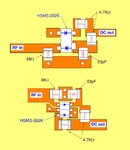per_lube
Advanced Member level 4

Hi,
I have to build a microwave power detector works at 11 GHz for a point to point communication application.
Could anyone shed some light on a good tutorial or some instructions on building a microwave power detector with Schottky barrier diodes at 11 GHz?
I found some datasheets and app. notes from Skyworks & Avago. They explain the theory well.
However they does not provide necessary information on practical implementation which makes difficult to understand the design steps for a novice like me
I got some specific problems:
1. Does the circuit requires an impedance matching circuit between input RF Port and diode?
2. What is the value for DC blocking capacitor for the RF input port at 11 GHz?
3. What is the best value for smoothing capacitor at the DC output side of the power detector for this freq. & how to determine it?
cheers,
per_lube
I have to build a microwave power detector works at 11 GHz for a point to point communication application.
Could anyone shed some light on a good tutorial or some instructions on building a microwave power detector with Schottky barrier diodes at 11 GHz?
I found some datasheets and app. notes from Skyworks & Avago. They explain the theory well.
However they does not provide necessary information on practical implementation which makes difficult to understand the design steps for a novice like me
I got some specific problems:
1. Does the circuit requires an impedance matching circuit between input RF Port and diode?
2. What is the value for DC blocking capacitor for the RF input port at 11 GHz?
3. What is the best value for smoothing capacitor at the DC output side of the power detector for this freq. & how to determine it?
cheers,
per_lube


